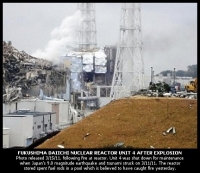Investigation finds NRC cancelled safety regulations designed to prevent hydrogen explosions at U.S. nuclear reactors such as those that occurred in Fukushima, Japan
 May 19, 2011—A scathing report critical of the U.S. Nuclear Regulatory Commission following the Fukushima Daiichi meltdown in Japan has been issued by Congressman Edward Markey’s office following an investigation into NRC procedures.
May 19, 2011—A scathing report critical of the U.S. Nuclear Regulatory Commission following the Fukushima Daiichi meltdown in Japan has been issued by Congressman Edward Markey’s office following an investigation into NRC procedures.
The report concludes that “flawed assumptions and under-estimation of safety risks are currently an inherent part of the NRC regulatory program, due to a long history of decisions made by prior Commissions or by the NRC staff that have all too often acquiesced to industry requests for a weakening of safety standards.”
Among the disturbing findings:
• 69 reports of emergency diesel generator inoperability at 48 reactors, with 19 failures lasting over two weeks
• NRC’s regulations do not require emergency diesel generators to be operational at times when there is no fuel in the reactor core, even though this could leave spent nuclear fuel pools without any backup cooling systems in the event of a loss of electricity
• The NRC has no requirements for spent fuel pools in the U.S. to include technologies to prevent the same kind of hydrogen explosions that occurred at Fukushima
• Astoundingly, after Fukushima, the NRC removed its previous regulatory requirements for reactor containments to include technologies to prevent hydrogen explosions
• The NRC has not required licensees to reduce amounts of nuclear fuel stored in spent fuel pools by moving it to dry cask storage, a safer method that reduces risk of fire and radiation release in the event of an accident
• The NRC has not factored modern geologic information into seismic safety requirements and ignored its own technical staff’s recommendations to do so—even though new info indicates a much higher probability of core damage caused by earthquakes than previously believed.
• The NRC has continued to process applications for license extensions on many reactors even in the absence of upgraded seismic safety requirements
• NRC’s post-Fukushima inspections in the u.S. are limited in scope and its nuclear reactor inspection reports “will likely exclude vulnerabilities from both the NRC and the public” due to limits imposed on reporting of the findings.
View the full report: http://a4nr.org/wp-content/uploads/2011/05/051211-Markey-Nuclear-Report.pdf








Comments
Image Correction
Thanks for the image update ECM.
No this way to prevent Nuclear Meltdown Again
I feel sorry to Japanese people due to Nuclear meltdown but I can't understand totally why the NRC did not learn from this lesson. Did their want this to be happen on USA? It human life involve and I don't think people will tolerance with this issue.
Be professional please, don't put people life on the line.
Thank
Regards
Gaharin
That's an Oil Refinery, Not a Nuclear Plant!
Please note, the picture in this article is a burning oil refinery in Japan, NOT the Fukushima Daiichi Nuclear Power Plant.
I've seen several cases where main stream media outlets show video of this burning refinery while discussing the nuclear plant with skyped in antinucler Greenpeace activists who paint a picture of the sky falling.
That burning refinery actually did hurt more people than the nuclear plant though.